Keywords
|
| PIC Micro controller, Soil Moisture Sensor, Water Sensor, GSM modem, UART Cable |
INTRODUCTION
|
| Growing plants is both an art and a science. About 95% of plants, either food crops or cash crops are grown in open field. Since time immemorial, man has learnt how to grow plants under natural environmental conditions. In some of the temperate regions where the climatic conditions are extremely adverse and no crops can be grown, man has developed methods of growing some high value crop continuously by providing protection from the excessive cold, which is called as Greenhouse Technology. Generally, a farmer uses less water with the aim of obtaining higher yield and crop quality which is attained by the better management of soil moisture during afflictive plant growth stages. But this excessive soil moisture can lead to growth of soil pathogens which leads to anaerobic conditions. The proposed methodology was implemented to monitor the soil moisture and the level of water in a tank. This moisture content can be measured using soil moisture sensor and the availability of water level in a tank can be measured using water sensor. The moisture content present in the soil is measured by the soil moisture sensor and fed to the microcontroller. The controller acts according to the control algorithm. The coding in the PIC controller is done using CCS compiler. The controller controls the motor to turn ON and OFF, when the moisture content goes above or below the limit. The value of the moisture content and motor functionality status shown in LCD display is to be acquired in LabVIEW is communicated by GSM module.GSM module act as both transmitter and receiver. It transmits data to another GSM module in the form of coded signals using AT commands.PIC controller in control side decode the same value in LCD display. Moisture content value can be monitored in LabVIEW via UART. The owner can access the status of agricultural field in another PC via Local Area Network. |
RELATED WORK
|
| 1.Yunseop Kim.2008 proposed remote sensing and control of an irrigation system using a distributed wireless sensor network [1]. The system has in-field sensing stations for sensing different parameters of field land and weather station for sensing micro metro logical information. The system uses Bluetooth, TCP/IP technology for sending data wirelessly. The system uses user friendly decision making program for controlled irrigation. The system gives a low cost solution for WSN. Bluetooth based solutions are also used for this purpose. Although Bluetooth eliminates the usage cost of the network to a great extent, main limitation of Bluetooth technology is its range of operation which is limited to a few meters. So one can remotely monitor and control devices using this technology but it is prerequisite for each controlling device design to have a dedicated Bluetooth module. As the single Bluetooth module is shared by several devices so it results in access delay. Interference is another very big problem of Bluetooth technology. |
| 2. Sankar.p.2009 proposed a wireless sensor network based system used for an intelligent temperature measurement system [2]. The system in use has digital multipoint thermometers for temperature measurement. System uses an advanced RISC microprocessor and Wireless Fidelity technology for data transmission. A special data storage file system is accomplished for reading and writing SD card, as well as for the management of the data file by the FAT16 file system. Wireless sensor networks are easy to establish without using cables and offers a greater flexibility. It have implemented their designs using 8-bit ATmega Series AVR processors with different size of programmable flash memory. It also has in built ADC with 516k EEPROM. It supports ISP mode and I2C BUS. |
| 3. Mahesh M. Galgalikar.2010 proposed Real-Time Automization Of Agricultural Environment for Social Modernization of Indian Agricultural System [5] focuses on using an ARM7TDMI Core 32-bit microprocessor, GSM services which operate through SMS as a link between ARM processor and centralized unit. GSM is used to inform the user about exact field condition through a SMS on user request. The GSM model is controlled by a standard set of AT (Attention) commands. The system continuously monitors the soil moisture, water level of the well, temperature, humidity, dew point, weather conditions and provides the details about the field to user though SMS. The system consists of a centralized unit having a subscriber number which forms a link between user and device and acts as a primary node for sending and receiving the data though SMSs by the user. The centralized unit communicates with the system through SMSs which will be received by GS with the help of SIM card; the GSM sends this data to ARM7, after processing it displays it on the LCD. The activation command is given to start the motor and indirectly activate the transistorized relay circuit to constantly monitor the environmental factors and once the required level is reached the motor is turned off and the message is sent to the farmer. It uses ARM7, low power consuming processor which is very important. GSM technology’s ready availability, simplicity, less signal deterioration makes it better for sending control signals and receiving updates over long distance. For critical applications requiring real-time monitoring the field condition can be transmitted using radio link. The drawback of this system was that GSM has a fixed maximum cell site range of 35km which is imposed by technical limitations. Secondly, the farmer needs to be familiar with the entire complex AT commands, and finally soil Parameters regarding fertilizers and plant diseases are not incorporated in the system. |
| 4. Vasif Ahmed, Siddharth A. Ladhake .2010 proposed a design of Ultra Low Cost Cell Phone Based Embedded System for Irrigation uses AVR ATMega32 microcontroller and includes protection against single phasing, over current, over voltage, dry running and probable bearing faults; and alerts the user through missed calls/buzzers on completion of tasks. RTC DS1307 and DS18S20 are used for time and temperature measurement. The system offers attractive features like automated control based on parameters specified though keyboard, SMS, number of missed calls in specified duration from user mobile though serial cable and based on the commands received and the present sensor conditions microcontroller system sends signal to the switch on-off the motor though starter using relay. Interfacing is done using RS232, AT commands is used. The SMS is a store and forward way of transmitting messages The system described in [6] provide optimum water distribution in fields based on manual settings, number of missed calls in specified time duration, SMS from cell phones. It ensures protection of motor against overloads and overheating and faces imbalances and also provides automated restarting. It uses buzzers, missed calls for alert purpose. It’s an ultra low cost due to usage of obsolete cell phone models. It has a dedicated voice based call approach for spoken commands to help the illiterate farmers. The only drawback it has is that it uses the same network operator for control system and user cell phones to ensure greater probability of successful connection; and it requires extra storage memory for adding other sensors. |
| 5. Gao Guohong and Liu Yi.2011 introduced an application based on single chip computer (AT89S52) in agriculture and landscape irrigation system is described in [7].The system has many functional units like clock unit, alarm unit and the display module. This approach reduces the staff workload, improves effective resource utilization, increases crop productivity and thereby reducing the cost of agricultural products. AT89S52 processor is used. These processor are of 8 bit with 256 byte RAM, 8K ROM and no EEPROM, ISP PWM, I2C and ADC |
SCOPE OF RESEARCH
|
| In this paper, irrigation field is monitored and controlled automatically using Wireless technology .The above research explains about various controllers and technologies which describes about the paper. The previous techniques were implemented with various controllers like AVR Atmega 16 microcontroller, Arduino controller, 8051and PIC Microcontroller were used to acquire data from different types of sensor which are about high cost. The existing wireless technologies like Bluetooth and Zigbee protocol are used only for short distance communication. Hence in this proposed methodology, PIC microcontroller is used which runs multiple processes at a time by controlling the motor. GSM modem is used for efficient communication. |
PROPOSED METHODOLOGY
|
| The Figure represents block diagram of wireless monitoring and controlling automatic irrigation field. |
BLOCKDIAGRAM DESCRIPTION
|
| Soil moisture sensor is used to measure the amount of moisture content present in soil. Moisture sensor data are fed to the microcontroller. PIC micro controller acts according to the control algorithm. Sensor output is analog in nature in the range of 0-5v. PIC controller converts analog data to digital data. When the moisture content present in the soil is dry, then water flow in a tank starts to flow in a pipe by turn ON the motor. When the moisture content in the soil is high, then the water flow in a tank stops to flow in a pipe by turn OFF the motor. The moisture content value and flow value is given to the GSM module in the form of control signals through AT commands.GSM module act as both transmitter and receiver, first it receives data from the PIC controller and transmits data to the receiver of another GSM module .Then it transmits same data to PIC through Max 232 chip. The same moisture content and flow level will be displayed in LCD display of PIC controller. Moisture content in the soil is acquired in LabVIEW through UART cable. Web page of the entire irrigation field is viewed in LabVIEW using Web publishing tool. The client can see the status of the field from the master via LAN connection. Hence Moisture values and the motor functionality status of irrigation field is viewed in LabVIEW. |
a. EXPERIMENTAL SETUP IN IRRIGATIONAL AREA
|
| Soil moisture probe is used to measure the amount of soil moisture present in the soil based on conductivity of the soil. Two zinc electrodes are placed to the depth of the soil. It measures the soil value in terms of voltage. It provides the voltage value in the range of 0-5V. Water is filled inside a tank in which water sensor is kept to measure the amount of water content in a tank. Motor starts to pump the water for discharging to the field, when the moisture content is dry. At the same time motor stops to pump the water for discharging. GSM module can be either interfaced with the PIC microcontroller or PC directly. GSM act as transmitter and receiver. It transmits the moisture content to the receiver side of another GSM module. The sensor values can be sent in the form of coded signal in terms of SMS using AT commands. PIC microcontroller has inbuilt ADC conversion and other features. It has capacitor to eliminate noise from the chip. Bridge rectifier is used to convert AC to DC. Regulator is used to regulate 12V DC to 5V AC. |
b. EXPERIMENTAL SETUP IN CONTROL SIDE
|
| GSM module act as both transmitter and receiver. It receives a data from the GSM module of field side in the form of coded signals using AT commands. MAX 232 is used for serial interface.PIC works in TTL logic level and operates at 5V.Hence MAX 232 is used to convert coded data signals into TTL logic. PC is used to acquire data from controller and displays the moisture content of the soil is graphically shown in LabVIEW. |
EXPERIMENTAL RESULTS
|
| The moisture content indication for dry soil and wet soil is graphically shown below is explained using LabVIEW. The data is acquired in LabVIEW via VISA resource name. It will display the values of GSM output values in the form of string and shows the changes of moisture content of the soil. |
| The figure 4 shows the motor status according to the moisture content of the soil in the field .The minimum set value is 20, but the moisture content in the soil which acquired in the graph is 18.Hence the motor has to be turned ON and the response is displayed in the graph. |
| The Figure 5 also shows the moisture content of the soil and motor functionality status. The maximum default value is 80, but the moisture content in the soil which acquired in graph is 81. Hence the motor has to be turned OFF and the response is displayed in the graph. |
CONCLUSION AND FUTURE SCOPE
|
| Thus the proposed methodology has implemented a wireless sensor network based on the soil moisture level monitoring system to control the motor. This system can rapidly realize the automatic networking irrigation system, transmission and display. Through the Web technology, we can realize the function of remote monitoring of the agricultural field. It shows that the system can meet the requirements of the moisture level of the soil, according to that motor can be controlled. Thus, the user can anytime view their sensor data details and the motor functionality status. The user can access the sensor details and motor functionality status from the PC via LAN connection. |
| In future, the system can be implemented by creating Web portal in which user can access the sensor details in LabVIEW in online. The system can also be implemented to measure sensors like temperature, humidity, fire, level, pressure etc. The optimized sensor output data can be obtained with the help of techniques like Genetic algorithm, fuzzy logic etc. |
ACKNOWLEDGEMENT
|
| First and foremost, I extend our deepest gratitude to God for showering His blessings and helping us to accomplish all our endeavors. |
| I am highly indebted to Dr.N.R Alamelu, M.E., Ph.D., Principal, Sri Ramakrishna Engineering College, Coimbatore for her support and facilities. |
| I also extend my heartfelt thanks to Dr. G. Mary Jansi Rani, M.E., Ph.D., Professor and Head, Department of CIE-PG, who had been guided me and given a source of inspiration and for her timely guidance in the conduct of my project work. |
| Finally, I would like to express my heartfelt thanks to my beloved parents for their blessings, my friends for their help and wishes for the successful completion of this project. |
| |
Figures at a glance
|
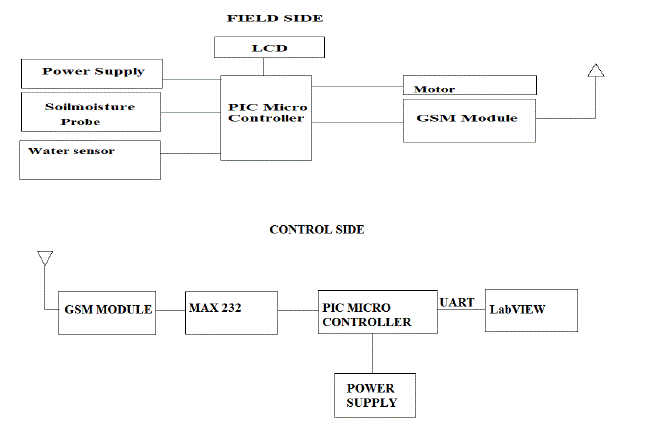 |
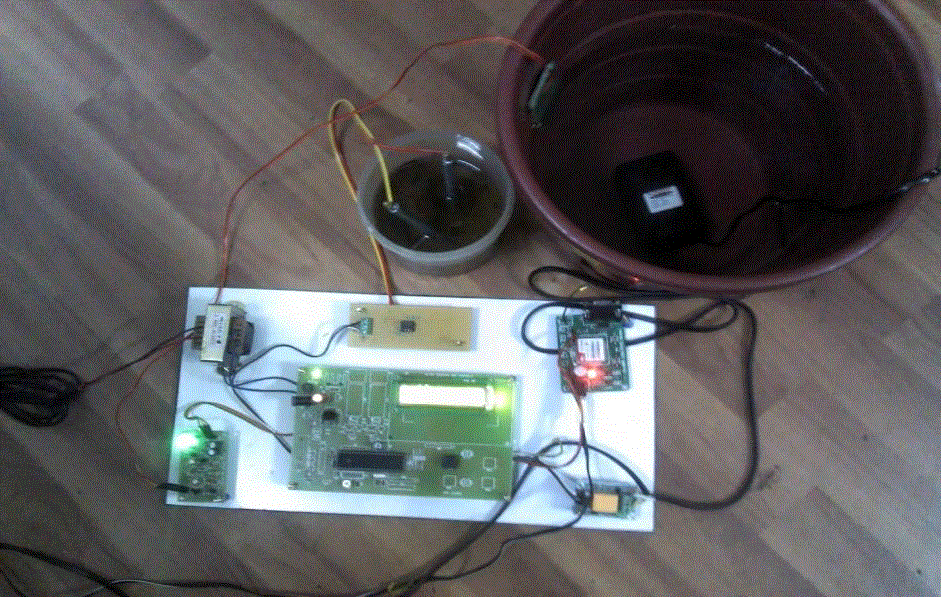 |
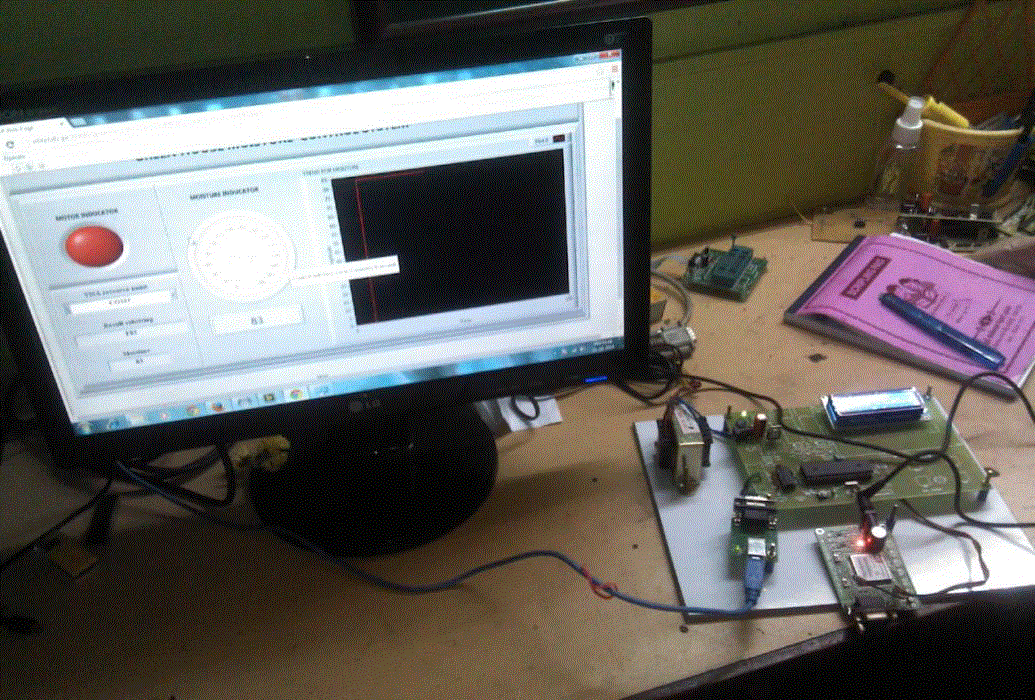 |
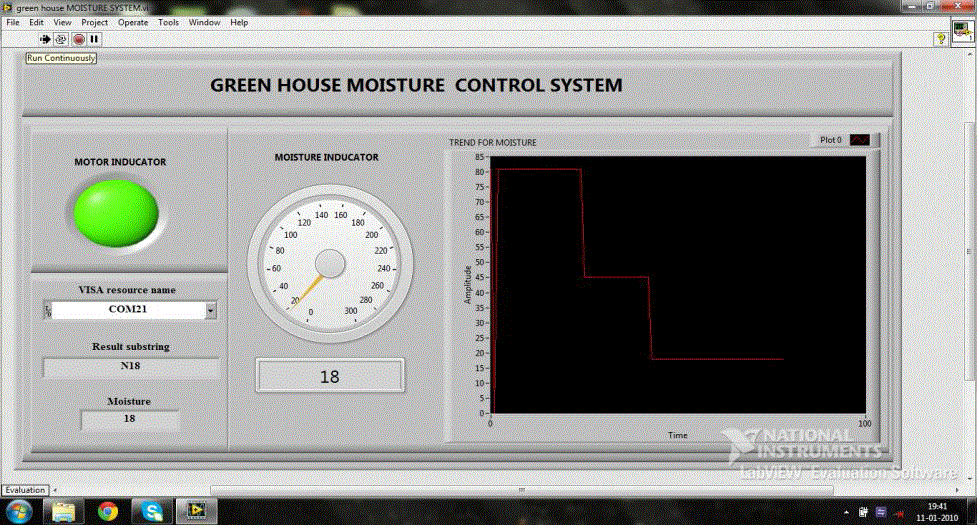 |
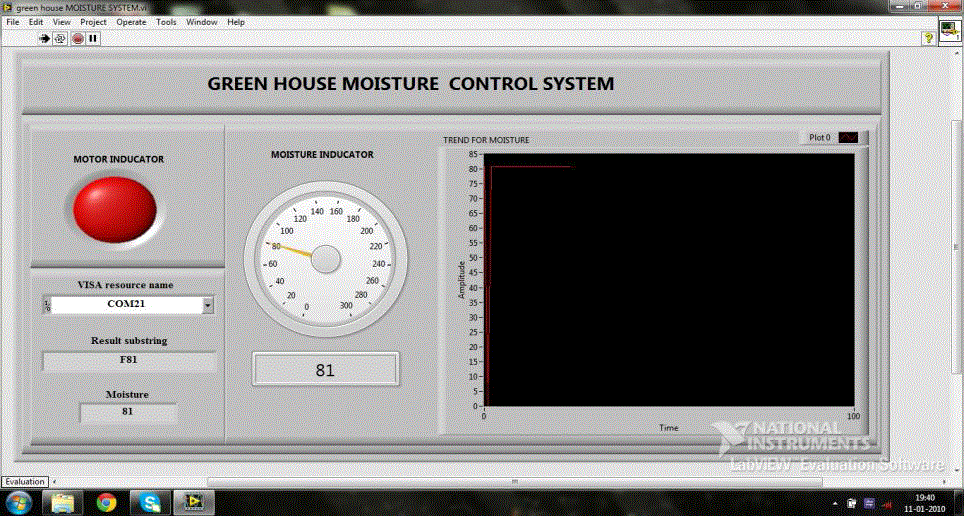 |
| Figure 1 |
Figure 2 |
Figure 3 |
Figure 4 |
Figure 5 |
|
| |
References
|
- YunseopKim,Robert G. Evans and William M.Iversen,(2007) “Remote sensing and control of irrigation system using a distributed wireless sensor network” IEEE transactions on instrumentation and measurement vol.57,pp-96-97
- Sankar, P., Norman, S.R,(2009) “Embedded System for Monitoring Atmosphere is Weather Conditions Using Weather Balloon”, International Conference on Control, Automation, Communication and Energy Conservation 2009, pp 1-4
- Md. Wasi-ur-Rahman, Mohammad TanvirRahman, TareqHasan Khan and S.M. LutfulKabir,(2009)“Design of an Intelligent SMS based Remote Metering System”,Proceedings of the IEEE International Conference on Information and Automation pp. 1040-1043
- Yan Xijun, Lu limei, XuLizhong,(2009)“The Application of wireless sensor network in the Irrigation Area Automatic System”, International Conference on Networks Security, Wireless Communications and Trusted Computing.vol.23, pp.21-24
- Mahesh M.Galgalikar,(2010)“Real-Time Automization Of Agricultural Environment for Social Modernization of Indian Agricultural System”, on IEEE Proceedings,pp 20-23
- Vasif Ahmed, Siddharth A. Ladhake,(2010) “Design of Ultra Low Cost Cell Phone Based Embedded System for Irrigation”, on International Conference on Machine Vision and Human Machine Interface ,vol.20,pp 40-45.
- GaoGuohong, Liu Y,FuJunhui and Wang Yingjun ,(2010 )“Design of time control irrigation system based on single-chip computer” second international conference on communication systems, networks and applications.
- L.L.Pfitscher, (2011) “An automated irrigation system for rise cropping with remote supervision”- proceeding of international conference on power engineering, energy and electrical devices, vol. 50, pp 90.
- Joaquin Gutierrez, Juan Francisco Villa-Medina, Alejandra Nieto-Garraway, and Miguel ÁngelPorta- Gándara “Automated Irrigation System Using a Wireless Sensor Network and GPRS Module “
- R. Yan, H. Sun, and Y. Qian (2013) “Energy-aware sensor node design with its application in wireless sensor networks,” IEEE Trans. Instrum. Meas., vol. 62, no. 5, pp. 1183–1191.
|